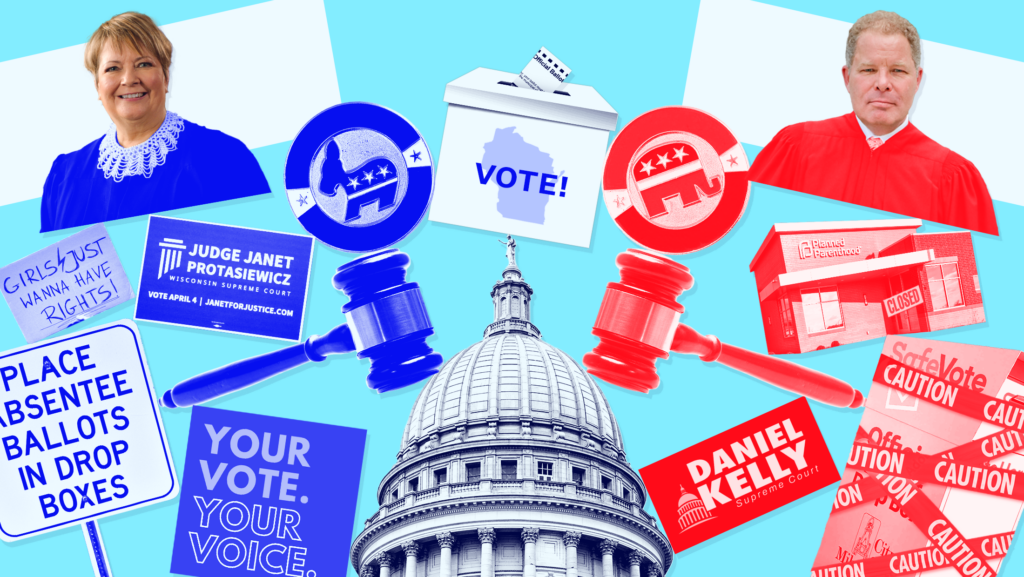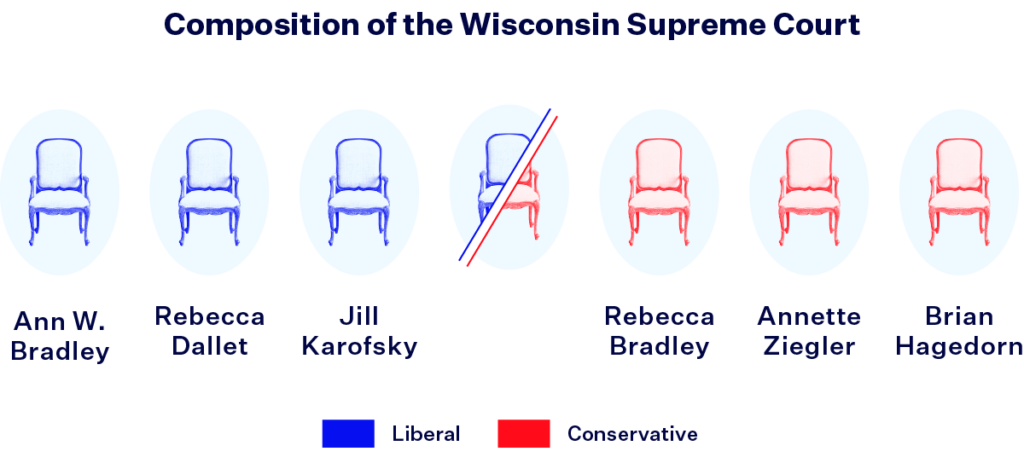What’s at Stake in the Wisconsin Supreme Court Election?

On April 4, 2023, control of the Wisconsin Supreme Court will be decided by voters. The court currently has a 4-3 conservative majority, but one of the bench’s staunchest conservatives, Justice Patience Roggensack, is retiring at the end of this term. This brings the balance of the court to 3-3, meaning that the future control of the court — which has been conservative since 2008 — is on the line in this election. Whoever takes over the open seat will tip the bench to the left or the right and likely weigh in on abortion rights in the state, any future legal challenges to districts and voting and more ahead of the 2024 presidential election.

While state Supreme Court races have historically been overlooked in the wider electoral landscape, their composition has widespread ramifications for voting rights, civil rights and a slew of other state policy implications. State Supreme Courts are also often the final arbiters of election disputes, as demonstrated in the 2020 election cycle. Given Wisconsin’s swing state status and the looming 2024 presidential election, the outcome of this Wisconsin Supreme Court race will have impacts not only on the state, but the entire country as well.
Who is running?
While Wisconsin Supreme Court elections are technically nonpartisan, the candidates in April’s election have identified themselves as judicially liberal or conservative and are backed by respective political groups. Once elected, justices serve 10-year terms on the state’s highest court.
Janet Protasiewicz is the liberal candidate. As previously profiled by Democracy Docket, Protasiewicz is a former prosecutor who has served as a Milwaukee County Circuit Court judge for nearly a decade. Not only has she been endorsed by Emily’s List given her pro-choice platform, but she has also been open about her views on the political unfairness of the state’s maps and expressed concern over the court’s past rulings — including its July 2022 decision banning drop boxes and third-party ballot collection — that restrict access to voting.
Daniel Kelly, who served on the Wisconsin Supreme Court from his appointment in 2016 until he lost re-election in 2020, is the conservative candidate. He has received over $3.9 million from individuals and organizations promoting the “Big Lie” that the 2020 election was stolen from former President Donald Trump, received endorsements from anti-abortion groups, expressed views against same-sex marriage and shared his view that courts cannot wade into partisan gerrymandering lawsuits. After Kelly lost his 2020 re-election bid to a liberal justice, he went on the Republican National Committee’s payroll to assist with “election integrity issues.” According to recent testimony provided to the U.S. House of Representatives, Kelly was involved in coordinating a rogue plan to send “fake electors” to cast the state’s electoral college votes for Trump, who lost to President Joe Biden by over 20,000 votes in the Badger State.
The Wisconsin Supreme Court plays an important role in deciding voting rights litigation.
State Supreme Courts wield immense power when it comes to upholding or blocking laws and rules that determine who can vote, how they can vote and if their vote is counted. As the final arbiter of state law in the state court system, state Supreme Courts largely get the last word on far-reaching voting rights and democracy-related lawsuits. In 2022, Democracy Docket found that 76% of democracy-related lawsuits were filed in state courts, further highlighting their important role in the voting rights landscape.
Wisconsin Supreme Court rulings from the last few years highlight this trend. During the 2020 election cycle, Trump focused much of his litigation blitz in the midwestern swing state in an overt attempt to take it from Biden. In a series of lawsuits, Trump and his allies tried to throw out valid absentee ballots and block certification of the state’s election results based on allegations of fraud and an overreach of power by the Wisconsin Elections Commission (WEC), the state’s bipartisan administrative body governing elections. Over and over again, the Wisconsin Supreme Court rejected these requests to invalidate votes — but only by a 4-3 vote. In the four rulings that the court issued pertaining to the 2020 election results, one conservative justice, Brian Hagedorn, joined the three liberal justices in dismissing the lawsuits. In each of these rulings, the remaining three conservative justices — including Roggensack — dissented and made it clear that they viewed the allegations raised by Trump and other right-wing actors to be worthy of review. In one such dissent, they asserted that the majority “leaves an indelible stain on our most recent election” by failing to take action on Trump’s request to invalidate 220,000 ballots in Democratic counties: “When the state’s highest court refuses to uphold the law, and stands by while an unelected body of six commissioners [of WEC] rewrites it, our system of representative government is subverted.” Thanks to Hagedorn’s swing vote, the rule of law prevailed in the state (and, in turn, the country), but by the slimmest margin possible — one that is now on the line in the upcoming election.
Beyond litigating cases during election cycles, the court has played an important role in recent voting rights and redistricting litigation. After gridlock between the Republican-controlled Legislature and Democratic governor stalled the map-drawing process following the release of 2020 census data, the court imposed new maps that largely carried over the partisan gerrymanders from the previous decade, marking the first time the state court system was involved in redistricting since 1964. After the U.S. Supreme Court threw out the first set of state House and Senate maps, the four conservative justices decided to replace the previously adopted maps drawn by Gov. Tony Evers (D) with ones drawn by the Republican-controlled Legislature, thereby decreasing representation for Black voters in the Legislature.
Later in 2022, the court’s four conservative justices banned the use of drop boxes and limited third-party ballot collection for mail-in voting (Hagedorn did, however, split with the other justices on their most extreme conclusions). The conservative justices had the chance to do what they weren’t able to in 2020: restrict mail-in voting and cast doubts on the results of the election by suggesting that the “illegality of these drop boxes weakens the people’s faith that the election produced an outcome reflective of their will.” The drop box opinion pieced together a shaky legal foundation to eliminate this safe method of voting across the state, quoting William Shakespeare and Kanye West and comparing the state’s 2020 elections to those in Iraq, Syria and North Korea along the way.
Why is this election in Wisconsin so important for future nationwide elections?
As the country turns to another presidential election in 2024, the justice who fills the open seat on the Wisconsin Supreme Court matters a great deal. Given its role as a consequential battleground state, Wisconsin became a target for litigation starting in 2020, a trend that continued through the 2022 midterms as the GOP sought to undermine mail-in voting. In 2022, Wisconsin saw the third-highest volume of litigation in the country, with three times as many lawsuits seeking to restrict voting access compared to those seeking to expand or protect voting rights. Ongoing litigation in Wisconsin state-level courts over various aspects of mail-in voting, from how absentee ballot witness certificates are completed to the use of mobile absentee voting sites, could eventually reach the state Supreme Court and impact future elections in 2024 and beyond.
Further, the state is all but guaranteed to be a target of the Republican Party heading into the 2024 election cycle, meaning that we can expect to see a deluge of litigation in state court seeking to limit who can access the ballot box and how. In 2020, the Wisconsin Supreme Court was one vote shy of wading into unprecedented waters around election results; different circumstances in 2024 could tip the scales in another direction.
Protasiewicz and Kelly offer two distinct paths forward. Referencing the attempts to overturn the results of the 2020 election, Protasiewicz noted that she is “deeply concerned that only a bare majority stood in favor of a very, very simple reading of the law…Three out of seven justices would have overturned the results of the Presidential Election in Wisconsin and hand[ed] the state’s electoral votes to Donald Trump.” On the flip side, Kelly worked closely with the GOP to devise a scheme to circumvent the rules of the Electoral College. Protasiewicz believes the court erred in its decision banning drop boxes and adopting certain districts; Kelly is a “judicial conservative” who believes that state courts cannot fix “political defects” in challenged maps.
In recent years, the Wisconsin Supreme Court’s conservative majority played a huge role in shaping the election landscape — for better, like in 2020, or worse, like in 2022. In these consequential cases, the court split on ideological lines, with the swing justice determining the path forward. With Roggensack’s seat open, the balance of the court faces two fates: a 4-3 liberal court or a 4-3 conservative court. It’s up to the voters on April 4 to determine which way it will swing.